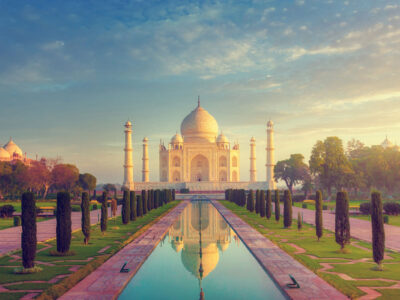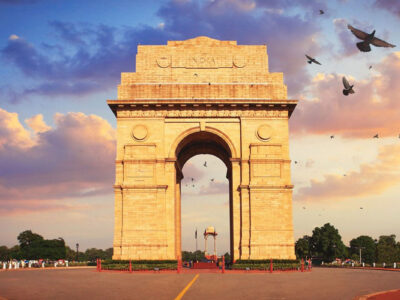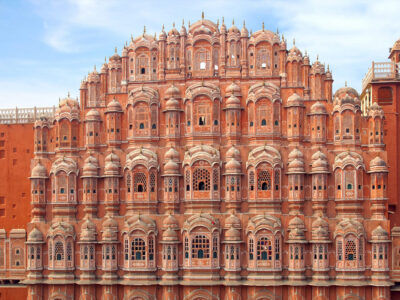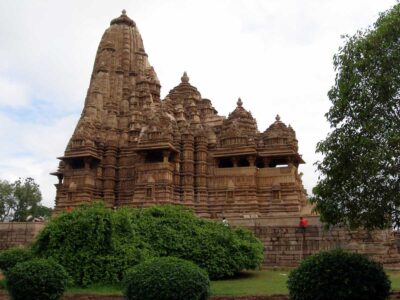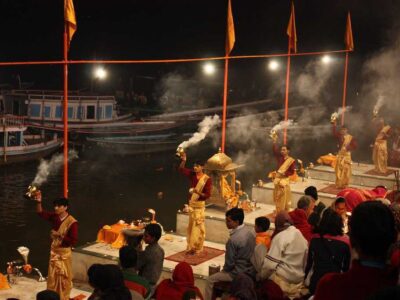The Golden Triangle,Varanasi with Tigers
The Golden Triangle, Varanasi with Tigers is a 13-day tour of North & Central India which includes two of India’s famous Tiger reserves and National Parks of Kanha and Bandhavgarh. This tour also includes some of India’s famous cultural tourist attractions, such as the metropolitan city of Delhi, with the beautiful cities of Ganges Varanasi, the erotic temples of Khajuraho, Agra the city of the Taj Mahal, and finally the Pink City, Jaipur. The National Parks in India are fairly different from their counterparts in Africa, but they are exciting and have a matchless Flora and Fauna of their own. Whereas, Kanha and Bandhavgarh are well known as Tiger reserves, these reserves apart from the Royal Bengal Tigers also support a whole lot of other animals and rare species too.
Activities
Day 01: Arrive Delhi, You are meet & greet with our company representative and he will escort you to the hotel and will help you with the check -In formalities. Day at your own leisure.
Overnight stay at hotel with Dinner.
Delhi - Delhi, an energetic city, with a unique blend of the ancient and the modern era. Delhi has divided into two parts New Delhi, the city created by the British in 1911 as the Imperial capital of India and Old Delhi considered as the Muslim capital of India between the 17th and the 19th century. Delhi is the unique blend of tradition & modernity. It is an architectural college of parks & flyovers, historical buildings and skyscrapers. People live here in different cultures, languages, states, traditions and countries in complete harmony.
Day 02: Delhi
After a relaxing breakfast, the tour guide will pick you up from the hotel and take you for a guided sightseeing of Old and New Delhi.
Full day guided tour of Old Delhi, the 17th century walled city of ShahJahanabad, visiting the great Jama Masjid, the principal mosque of Old Delhi. Built in the year 1656 AD by the Mughal Emperor Shah Jahan, it is the largest & best known mosque in India. Later take a rickshaw ride through Chandni Chowk, the old marketplace of ShahJahanabad now a picturesque bazaar.

In New Delhi, visit Raj Ghat, memorial to the Father of the Nation, Mahatma Gandhi. It is a simple black marble platform that marks the spot of his cremation on 31 January 1948.
We will stop for lunch at Good local Restaurant. Afterwards visit Humayun Tomb, This tomb, built in 1570, is of particular cultural significance as it was the first garden-tomb on the Indian subcontinent. It inspired several major architectural innovations, culminating in the construction of the Taj Mahal.
Further we drive past India Gate, memorial built in the year 1931 to commemorate the Indian soldiers who died in World War I & the Afghan Wars. The names of the soldiers who died in these wars are inscribed on the walls. President's House, the official residence of the President of India, built in the year 1931. Until 1950 it was known as Viceroy's House & served as the residence of the Governor-General of British India.
Culminate the day at Qutub Minar, built in the year 1206 by Qutub-ud-din Aibek. It is the tallest (72m) brick minaret in the world, an important example of Indo-Islamic Architecture.
Overnight stay at hotel. (B,L,D)
Day 03: Delhi – Varanasi (By Flight AI 406 departs at 10:15 hours / arrives at 11:35 hours)
Upon arrival you are meet & greet by our company representative later you are transferred to your pre-booked hotel.

Varanasi or Banaras, mentioned in the scriptures as Kashi, is less of a city and more of a dreamy experience. It is a paragon of Indian culture, philosophy, traditions and spiritual ethos since times immemorial. It is among the Sapta Puries, meaning seven sacred cities of Ancient India. The city is located on the bank of River Ganga which has two tributaries in the city: Varuna and Assi; hence the name Varanasi. The combination of Kashi – the holy city, Ganga- the sacred river and Shiva- the supreme God, makes Varanasi an immortal destination. Today, Varanasi remains the hub of cultural and holy activities. In the field of learning, especially of Religion, Philosophy, Yoga, Ayurveda, Astrology, Dance and Music, the city is certainly unparalleled. The Banarasi Silk Sarees and Brocades are known worldwide for its elegance. Varanasi is full of surprises abounding every corner; the more one explores it, the more one falls in love with it !!
Later afternoon take rickshaw ride to the Old City where you can have a bit of time to stroll the wonderful stimulating area in the Old City around the Ganges. You can walk the narrow cobbled alleyways browsing bazaars and people watch as locals prepare for the evening Aarti. Just before sunset, we will board a country boat to witness Aarti (fire) ceremony performed by a Hindu priest on the banks of the River Ganges.
Overnight stay at hotel.
Day 04: Varanasi

Early morning pick up for a very moving sunrise boat ride on the River Ganges to witness the religious ceremonies of Hindus. Afterwards, a walking tour of temples and ghats.
Return to the hotel for breakfast and some time to rest from the early wake-up call, if you desire.
In the late morning (depart at approx 11 am), to visit Banaras Hindu University, regarded as the largest residential universities in Asia.
Bharat Kala Bhavan, located inside the BHU campus, is an art and architecture museum and houses a vast collection of paintings, Hindu and Buddhist sculptures and other materials of archeological importance. The Bharat Kala Bhavan was established in the year 1920 A.D. Bharat Kala Bhavan also has a great collection of miniature paintings from the courts of Mughals and other Kingdoms and principalities. Some of the important sections in the Bharat Kala Bhavan are Mahamana Malaviya gallery, Nicholas Roerich gallery, Chhavi (Painting Gallery), sculpture gallery, Nidhi (Treasures) gallery, sculpture gallery, archaeological gallery, decorative art gallery and Banaras through ages gallery.
Return to your hotel for lunch and refresh.
This afternoon, visit Sarnath where, in 500 BC, Lord Buddha preached his first sermon 'Maha- Dharma-Chakra Pravartan Sutta' (in Buddhist terminology, ‘turn the wheel of the law’) after his enlightenment. The very spot is marked by the Dhamekh Stupa, adorned with delicate floral carvings. You can walk the path, located in the midst of the archeological park, to see the ruins of the small brick monastery where Buddha lived during his visits. About 600 meters before the Archeological Museum, you will see the Chaukhandi Stupa. The excellent Archeological Museum contains an extremely rich collection of Buddhist sculptures of numerous Buddha and Bodhisatva images.
After visiting the museum, continue to Mahabodhi Society’s Mulagandha Kuti Vihar Temple. A major place of worship for the Buddhist community of the world, it was constructed by Bodhisatva Anagarika Dharmapala (1864-1933) from Sri Lanka at the very site where Shakyamuni Buddha preached his first sermon. The temple contains excellent frescoes painted by Japanese artist Kosetsu Notsu. He single handedly completed these paintings in a four year span (1932-36). It also houses a life size statue of Buddha in its sanctum and Gautam Buddha's holy relics are kept on display in the shrine. The monarchy of Japan has gifted a large bronze bell that dominates the entrance of the Vihar. The temple was opened to public on Nov. 11th, 1931 and the Mahabodhi Society of India oversees its affairs.
A Bodhi tree stands on the left (east) side of the temple that is believed to have grown out of a sapling of the one under which Buddha attained enlightenment at Bodhgaya. Under this tree statues of Buddha and his disciples have been displayed. The casket of the sacred relics is taken out in a great procession from Mulgandha Kuti Vihar and goes around this tiny city of Sarnath annually on the anniversary day of Mulgandha Kuti Vihar, which falls on Kartik Purnima (Full moon day) in the month of Nov.
At approx 6pm, local Buddhists chant the words to Buddha's first sermon.
Overnight stay at hotel.
Day 05: Varanasi – Khajuraho (By Flight AI 406 departs at 12:10 hours / arrives 14:40 hours)
After relaxed breakfast you are transferred to Varanasi airport to board flight for Khajuraho. Upon arrival at the airport you are meet & greet by company representative afterwards you are transferred to your pre-booked hotel.

Khajuraho was once the capital of the Chandela Rajput’s of Bundelkhand. It is the dwelling place of the World’s famous 10th century Khajuraho Temples. These temples have attractive and erotic rock carvings and the carvings symbolize some of the beautiful specimens of the medieval Hindu architecture and sculpture in the country.
Overnight stay at hotel.
Day 06: Khajuraho – Bandhavgarh (By surface 250 Kms / 05 Hours drive)
After breakfast, Half day guided city tour of Khajuraho visiting Eastern & Western Group of Temples. Later
drive to Bandhavgarh National Park.
Bandhavgarh National Park: Bandhavgarh is a comparatively new National Park, and amongst the most popular Tiger Reserves in India. The Park is extremely popular because of its high density of Tiger population, being a relatively smaller park. There is also a lovely fort in the middle of the park, which doubles its charm. The park has a huge biodiversity. Bandhavgarh National Park also has a huge breeding population of leopards, Jungle cats, Rhesus macaques, hyenas, blackbucks and various species of mammals and 250 species of birds.
Upon arrival at Bandhavgarh, check in to the resort.
Overnight stay at resort.
Day 07: Bandhavgarh
Morning and Afternoon Safaris into the Bandhavgarh National Park accompanied by an English speaking Naturalist.
Overnight stay at resort.
Day 08: Bandhavgarh – Kanha (by surface 325 Kms / 06 Hours drive)
After breakfast, we drive to Kanha National Park.
Kanha National Park: Kanha National Park, one of the original Sanctuaries to be part of the Project Tiger programme, is one of the largest National Parks in Asia. Kanha not only boasts of India’s largest Tiger population, but is also known for it’s conservation efforts of the Barasingha (Swamp Deer), the population of which has increased over seven fold in the last 40 odd years. The Kanha National Park has a diverse landscape and a hugely varied topography including hilly areas, thick forest and open grasslands. This varied landscape offers a unique habitat to a variety of animals, which, in addition to Tigers include Chital (spotted deer), Langur Monkeys, Wolves and the elusive leopard.

Upon arrival at Kanha, check in to the resort.
Overnight stay at resort.
Day 09: Kanha
Morning and Afternoon Safaris into the Bandhavgarh National Park accompanied by an English speaking Naturalist.
Overnight stay at resort.
Day 10: Kanha – Jabalpur (by surface 200 Kms / 04 Hours drive)
The day starts with an early morning game safari into the Kanha National Park, once again accompanied by a local Naturalist.
Afternoon drive to Jabalpur Railway station to board the overnight train to Agra.
Overnight on board Train.
Day 11: Agra
Since train is arriving morning around 08:00 hours so we need to block rooms from previous night (Check In time is 14:00 hrs & Check out time is 12:00 hrs)
Upon arrival at Agra Cantt Railway station, you will meet & greet by our company representative later you are transferred to your pre-booked hotel.
Agra: Agra is situated on the banks of the Yamuna River. It is the dwelling place to India’s famous monument, the Taj Mahal. Agra was the capital of Mughal Empire in the 16th & 17th centuries. The city of Agra has an indelible mark on the global map as home to one of the Seven Wonders of the World, the Taj Mahal. But there is more to the city than just the Taj. From monuments, shrines and tombs dedicated to love, to the most intricately carved handicrafts, sprawling landscaped gardens, and delicious food, there is a lot that makes Agra one of India's most loved tourist attractions. Roam around its ancient lanes and you would know what makes it such a hit.
Afternoon you will meet your guide in hotel lobby for half day guided tour of Agra visiting Agra Fort & Itimad-ud-Daulah.

Agra Fort: Emperor Akbar started the construction of this huge red sandstone Agra Fort on the bank of the Yamuna River in 1565. It was mainly constructed for the soldiers until his grandson, Shah Jahan, added more opulent accommodations. There are a number of attractive buildings within its porches such as Samman Burj, where Shah Jahan was imprisoned by his son, Moti Masjid, a white marble mosque, Diwan–e–Am, Diwan–e–Khas, Jahangir’s Palace, Khaas Mahal and Sheesh Mahal.

Itmad-ud-Daulah's tomb is a highly ornate edifice, which is looked upon as an imminent precursor of the Taj Mahal as far as elaborate carvings and inlay work are concerned. The tomb marks a significant departure from the tombs of the Mughal dynasty built before its construction. The pure white and elaborately carved tomb of Itmad-ud-Daulah conforms to the Islamic style of architecture. The use of arched entrances, octagonal shaped towers or minarets, use of exquisitely carved floral patterns, intricate marble-screen work and inlay work are all representative of the Islamic style
Suggest Lunch at Pinch of Spice restaurant.
Overnight stay at hotel.
Day 12: Agra- Jaipur (By road 250 kms, 5 hours drive)

Early morning visit the Famous Taj Mahal at Sunrise a fine example of the Mughal Architectural Styles is one of the seven Wonders of the Modern World. Built in 1652 by Emperor Shah Jehan in memory of his wife Mumtaz Mahal Taj Mahal was built in white marble which took 22 Years to build by 20,000 skilled artisans. The Building’s stupendous scale, flawless symmetry, translucent white marble and shimmering reflection in the water channels are truly breathtaking After viewing Taj Mahal we return to hotel for breakfast.
After breakfast drive to Jaipur enroute visit Fatephur Sikri, built in 1571, one of the world's most perfect ghost cities and a marvel of design and construction. It is a synthesis of the flourishing styles of the Persian courts and the prevailing Hindu-Islamic trends. Fatehpur (town of victory) Sikri was built by Akbar, the third and greatest of the Great Mughals. It is over 400 years old and today its pristine red sandstone buildings are as perfect as when they were first chiseled.
The town was erected after a holy man, Sheikh Salim Chisti, decreed the births of three sons to Akbar after all his children had died in infancy. There are three sections to the City: The Royal Palace (notable for the Emperor's throne), the outside of the Royal Palace and the Jami Masjid (the location of the Tomb of Sheikh Salim Chishti, a masterpiece in brilliant white marble). The centerpiece of this remarkable monument is the Jewel House of the Diwan I Khas. Architecturally extraordinary, the four doorways lead into a single-story room where a huge central pillar supports a seat reached by mid-air walkways.
Upon arrival at Jaipur you are check In to your pre-booked hotel.
Evening you can walk around the Local Bazaars.
Overnight at hotel. (B,L,D)
Day 13: Jaipur
Morning drive to Amber, the name of the ancient kingdom of Jaipur and also the name of its ancient capital, situated 7 miles away. Its history can be traced back to the 12th century. Amber Fort is superbly located, protected by the wild Arrival Hills on all sides. Originally built in the 11th century, it was expanded by Raja Man Singh in the late 16th century. The ascent to the Fort will be on elephant backs.
Afternoon: city tour including the City Palace, Hawa Mahal (Palace of Winds), Jantar Mantar Observatory, bazaars.

Known as the “Pink City,” Jaipur was founded by Sawai Jai Singh II (1700-1743). It has 7 gates into the city--one for each of the 7 planets (which was the number of planets known at the time of the city’s founding). At the heart of Jaipur is its City Palace which houses an extensive collection of rare manuscripts, Mughal and Rajasthani miniatures, Mughal carpets, costumes and textiles, arms and weapons, royal buggies, chariots and palanquins and a remarkable carriage -the indiraviman - that was drawn by four elephants.
At the center is Chandra Mahal, the seven-tiered moon palace where the present Maharaja still resides. The City Palace complex also contains the Govind Devji Temple, dedicated to Lord Krishna. Just outside the gateway of the City Palace is Jantar Mantar, the Yantralaya of Sawai Jai Singh II, the last great classical astronomer in India. The modernistic structures known as Yantras are the unique creations of this astronomer-king, designed by him and built by experts to observe the movements of the sun, moon, planets and stars. This is the largest of five observatories founded by the astronomer-king in various parts of the country. Hawa Mahal (Palace of Winds) is Jaipur's most-photographed building, a honeycomb palace with 953 latticed windows overlooking the bazaar and busy streets of Jaipur. Built in 1799 by the poet-king Pratap Singh, this extraordinary building was used by purdah-bound women to watch the grand processions that were a regular feature of the city.
Dinner at Surabhi Restaurant & Turban Museum.
Overnight at hotel. (B,L,D)
Day 14: Jaipur – Delhi (270 Kms / 5 Hours drive)
Late morning we will drive to Delhi. Upon arrival check-in to hotel near airport for wash & change. Late evening transfer to New Delhi IGI airport for your onward journey.


